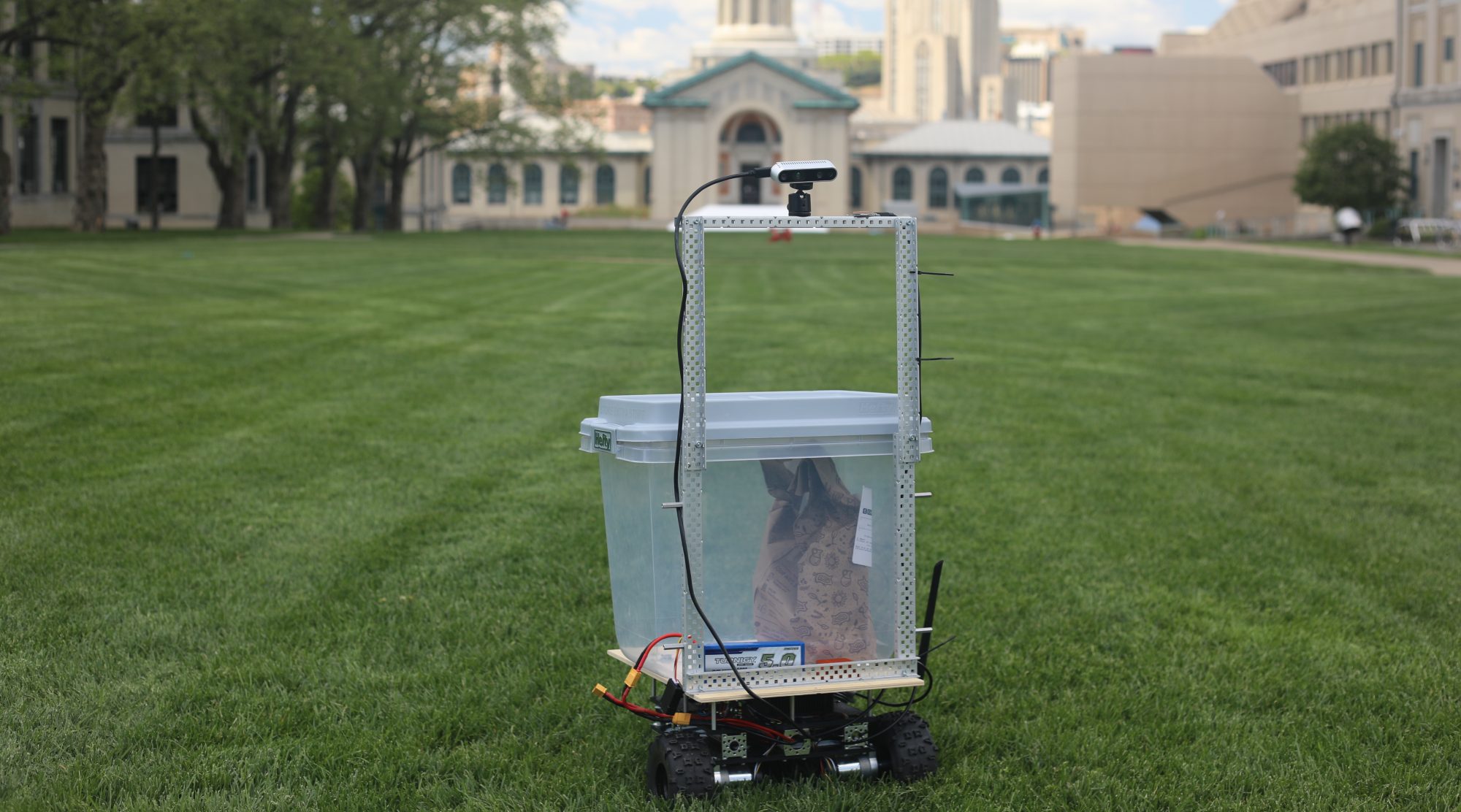- Current Risks and Mitigation
- In our initial testing, running SLAM on the Xavier using the ZED mini had low fps (10). Advaith found that many people have this problem using the default ROS wrapper on the Xavier and had to make modifications.
- We are at risk of going over-budget due to the high cost of high power motors and controllers, and our custom frame. Our mitigation strategy is to look into prebuilt bases and potentially relaxing our requirements to allow for less powerful hardware.
- We did calculations to determine our motor and battery requirements, but the calculations use some assumptions. We use a safety factor of 1.2, but in the case that this was not enough overhead, we would mitigate by relaxing our speed, weight, and battery duration requirements
- Changes to System Design
- Decided on depth cameras over lidar for vision due to budget constraints; we have an Intel RealSense already.
- Schedule Changes
- No changes to our schedule this week.
- Progress Pictures
- 3D map built by the SLAM algorithm
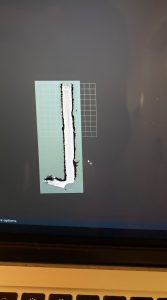

Sebastian’s Status Report for 2/27/2021
- Accomplishments
- Ordered a Jetson Xavier from the 18500 spare parts
- Installed ROS on my personal machine and started this ROS introduction – https://rsl.ethz.ch/education-students/lectures/ros.html
- Worked with team to calculate motor requirements
- Worked with team to draft parts list, and then started reducing our cost to meet the $600 budget
- Progress Timeline
- Our progress is on schedule
- Next Week Deliverables
- Write a hello world communication program between the Xavier and someone’s personal machine through ROS
- Do the design review slides
- Begin ordering parts
- Integrate simple devices to the Jetson if they arrive (eg wifi dongle)
Michael’s Status Report for 2/27/2021
- Accomplishments for the week:
- This week, most of my time was spent implementing the multi-order algorithm. It actually works!
- It’s a backtracking algorithm that recurses on all possible states of the robot, and precomputes all shortest paths between nodes on an input graph to speed up algorithm computation.
- It returns the first series of moves that it finds to be satisfactory to our timing requirements, so it’s just a constraint satisfaction problem for now.
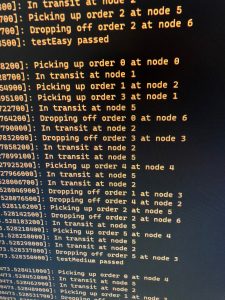
- I also started on a ROS node that can act as the global planner, which takes in orders and sends commands and waypoints to the robot.
- There are two APIs for the ROS node: the first is the algorithm solver API and the second is the global planner node.
- The repo is here: https://github.com/pythonicmux/multiorderAlgorithm
- To test the algorithm, I created a weighted undirected graph of the engineering area of campus (that’s located in the test file on the repo, multiorder_alg_node.cpp). The weights are based on distances between selected road intersections on campus.
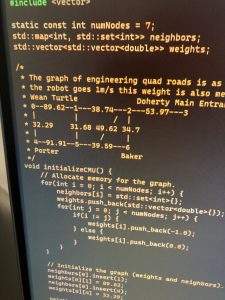
- I assisted Advaith in trying out SLAM outdoors and setting up the Xavier to try localization on it.
- I gave the proposal presentation and helped out with parts prediction, doing some calculations to ensure that our motors can supply enough torque for the inclines and the battery can power everything.
- This week, most of my time was spent implementing the multi-order algorithm. It actually works!
- Progress:
- I am currently on-schedule with my tasks.
- Next week’s deliverables:
- Next week, my deliverables are to finalize the global planner code and thoroughly test it with unit tests and a simulation of a user sending it orders and robot sending it status updates.
- Possibly make the multiorder algorithm an optimization algo by minimizing total distance travelled + NP hard proof??
- Design presentation slides
- Parts ordering
Advaith’s Status Report for 2/27/2021
- Accomplishments
- Tested the SLAM algorithm on campus.
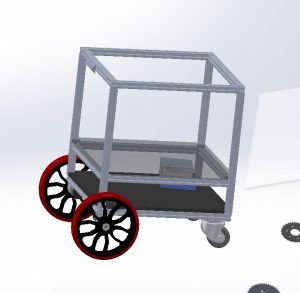


- Finalized the CAD design
- Tested out the SLAM algorithm under different lighting conditions
- Wrote a PD line following algorithm in ROS using Gazebo
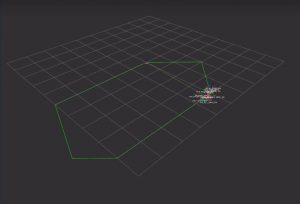
- Installed ROS on the Xavier with Michael
- Brought the IMU into ROS using pyserial.
- Schedule Progress
- We are on schedule for our project. We will be working on the Design Presentation in the following week and ordering parts.
- Deliverables for Next Week
- Finalize the parts list and order parts
- Begin working on the collision avoidance algorithm
- Finish the design presentation and practice giving it using the feedback from the last presentation.
Team Status Report for 2/20/2021
- Current Risks and Mitigation
- There is a risk that the WiFi on campus will not be consistent enough for our latency requirements. One contingency plan we have is to place a cellphone with a hotspot onboard the robot if the campus WiFi is not satisfactory. But this likely has implications for our ROS network since it would traditionally run in a local area network.
- Another risk is that localization algorithms may not work on campus. A mitigation plan is to test building a map on campus using an Intel Realsense before ordering parts, so we can finalize the correct sensor modalities. Contingency plan is to use fiducial markers.
- Changes to System Design
- Changed our design from 2 motors per driver to 1 motor per driver based on feedback from Prof. Kim. Using multiple motors on a driver would make accounting for any minor differences between motors very difficult.
- Decided on WiFi over LTE as our target for low-level communication protocol based on the suggestion from Prof. Kim that it is simpler to integrate into our robot.
- Schedule Changes
- No changes to our schedule this week.
- Progress Pictures
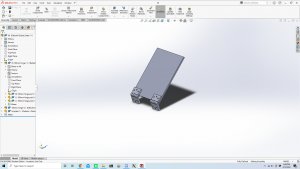
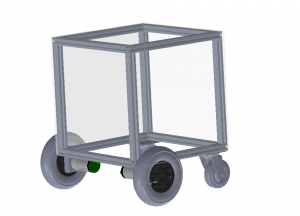
Michael’s Status Report for 2/20/2021
- Accomplishments for the week:
- This week, I learned many of the necessary skills needed to build this robot, namely using CAD and programming C++ on ROS.
- I used Solidworks to create a lid for the robot:

- I did the entirety of the ETH Zurich ROS Course (https://rsl.ethz.ch/education-students/lectures/ros.html) to learn ROS.
- This involved writing ROS nodes and services for a simulated Husky robot with many sensors- I wrote a P controller that drove the Husky toward a pillar based on its laser sensor readings and also a ROS service/node to stop the robot before a collision.
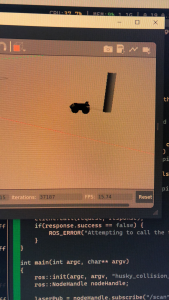
- Above is a picture of the husky after it drove to the pillar and stopped.
- This involved writing ROS nodes and services for a simulated Husky robot with many sensors- I wrote a P controller that drove the Husky toward a pillar based on its laser sensor readings and also a ROS service/node to stop the robot before a collision.
- I also began thinking of the problem state for the multi-order algorithm. I’m pretty sure it’s NP-hard, but I’ll have to prove it to be sure.
- Progress:
- I am currently on-schedule with my tasks.
- Next week’s deliverables:
- Next week, I’m giving the proposal presentation.
- I have to clearly state the multi-order problem mathematically, and come up with a brute-force solution that can find a non-optimal solution to a multi-order problem instance.
- I also want to come up with a simulated weighted, undirected graph of where the robot can travel to in order to facilitate a basic, brute force implementation that can solve the multi-order problem.
- Ideally, I can write a working brute-force algorithm that solves any simulated problems and start working on a polynomial-time algorithm (or better brute-force, if I can prove it to be NP-hard).
Sebastian’s Status Report for 2/20/2021
- Accomplishments
- Setup project website pages, categories, and tags
- Explored various Gantt chart platforms/tools and selected TeamGantt
- Investigated networking requirements to run ROS
- Worked on proposal presentation slides and Gantt chart with the team
- Progress Timeline
- Our progress is on schedule
- Next Week Deliverables
- Learn how to write ROS nodes for device drivers
- Learn how to set up various ROS network architectures
- Decide on an appropriate network architecture for our project
- Read about collision avoidance strategies
Advaith’s Status Report for 2/20/2021
- Accomplishments
- This week, I worked on the CAD model for our robot. I am using Solidworks and bringing in models of motors, wheels, and 8020 aluminum rods to get a better spatial idea of our robot design. This will help us plan for materials and make it easier to change our design based on our requirements.

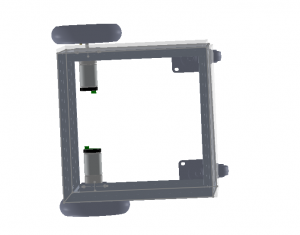
- I tested RTABMAP using an Intel Realsense camera using ROS. This is to test if it is a viable algorithm for our project. These tests should be done before buying parts, as the perception sensor is a significant investment.
- I tested a basic Pure Pursuit controller in MATLAB with simulated differential drive robot.
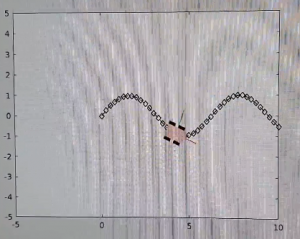
- Worked with team on Proposal Presentation
- This week, I worked on the CAD model for our robot. I am using Solidworks and bringing in models of motors, wheels, and 8020 aluminum rods to get a better spatial idea of our robot design. This will help us plan for materials and make it easier to change our design based on our requirements.
- Schedule Progress
- We are on schedule for our project. We have completed the majority of the Proposal Presentation.
- Deliverables for Next Week
- I wish to complete the CAD model with all boards, actuators, and sensors so that we can finalize our BOM.
- Full testing of perception algorithms including ORBSLAM, RTABMAP, and HectorSLAM
- Bring the IMU into ROS
- I have a Bosch IMU that I want to test using ROS
- Involves getting the driver running through a Teensy, then writing a ROS wrapper node.
- Write a basic waypoint following robot in ROS using a simulated robot
- Will shed some light on the controls aspect of the project
Hello world!
GrubTub will save your life in a snowstorm. GrubTub will make sure you get those gains. GrubTub will revolutionize the campus food delivery industry.
